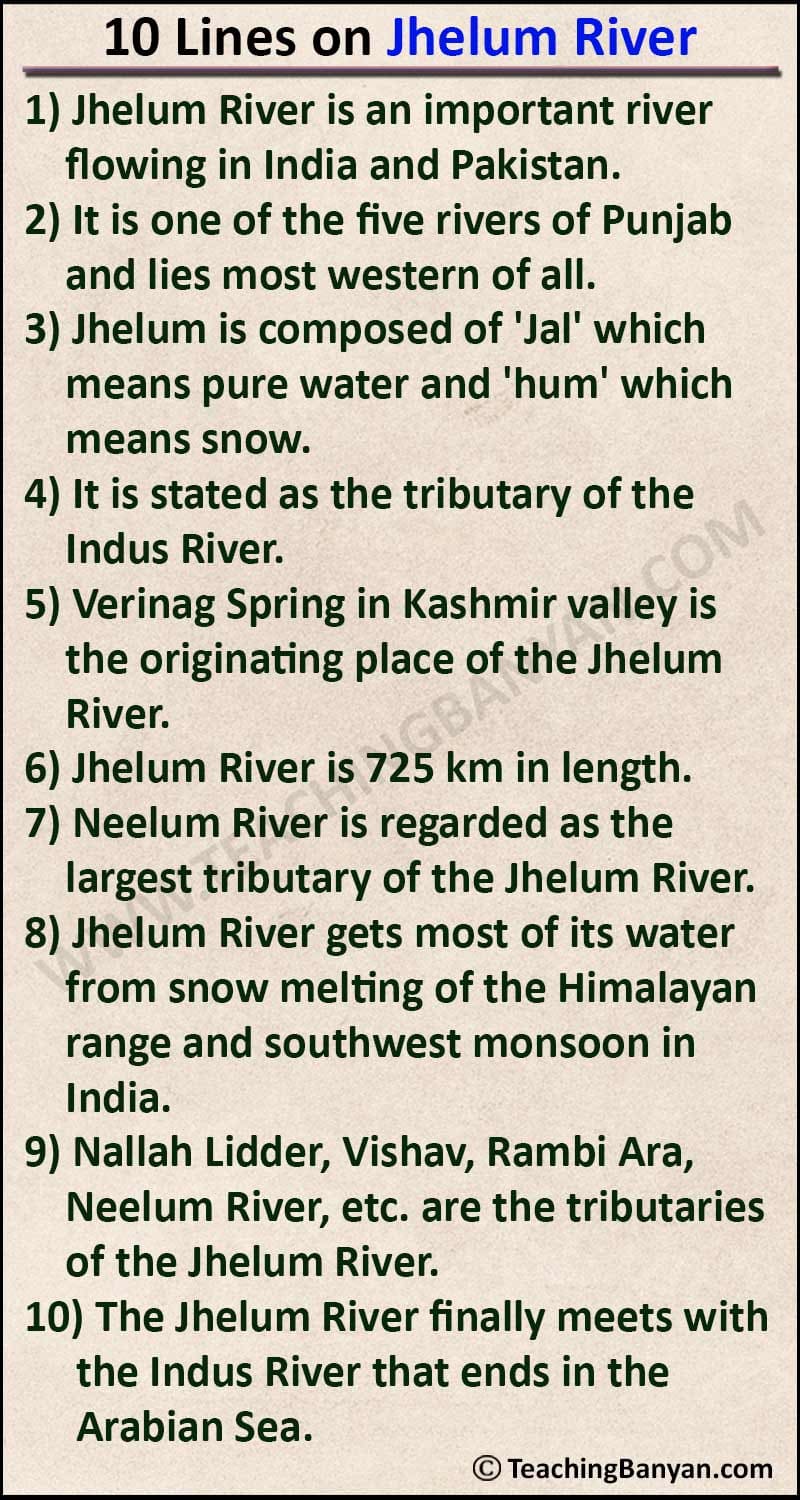Jhelum River is one of the five rivers which flows through Punjab region. The river originates from Jammu and Kashmir and from there it flows into Pakistan from PoK (Pakistan Occupied Kashmir) and assimilates with River Chenab in Pakistan. It is also a tributary of the River Indus. It is a transboundary river flowing through the countries of India and Pakistan and provides irrigation as well as electricity facility to the people.
It originates from Verinag Spring near Anantnag district of Jammu and Kashmir and it covers Uri and Baramulla while entering Pakistan. Jhelum River is the main river in the Punjab province of Pakistan. Jhelum city is located on the river banks and the city’s name was kept on the river’s name.
Ten Lines on Jhelum River in English
10 Lines on Jhelum River – Set 1
1) Jhelum River is the largest and most western among the five rivers of Punjab.
2) It passes through Jhelum district and it is a tributary of River Indus.
3) The total length of Jhelum River is 725 km and the drainage area is 15,856 square km.
4) Jhelum River originates from the spring of Verinag in Anantnag, Jammu and Kashmir.
5) Jhelum River flows through Srinagar and Wular Lake before entering Pakistan.
6) Neelum River is the largest tributary that joins Jhelum River in Pakistan.
7) Jhelum River also connects Pakistan and PoK on Kohala Bridge east of circle Bakote.
8) The river basin has 24 tributaries and some of them originate from the Pir Panjal range.
9) Jhelum river basin area is considered to be the storehouse of their medicinal plants.
10) There are 147 glaciers in Jhelum river basin which covers an area of about 75 lakh sq. km.
10 Lines on Jhelum River – Set 2
1) Jhelum River is an important river flowing in India and Pakistan.
2) It is one of the five rivers of Punjab and lies most western of all.
3) Jhelum is composed of ‘Jal’ which means pure water and ‘hum’ which means snow.
4) It is stated as the tributary of the Indus River.
5) Verinag Spring in Kashmir valley is the originating place of the Jhelum River.
6) Jhelum River is 725 km in length.
7) Neelum River is regarded as the largest tributary of the Jhelum River.
8) Jhelum River gets most of its water from snow melting of the Himalayan range and southwest monsoon in India.
9) Nallah Lidder, Vishav, Rambi Ara, Neelum River, etc. are the tributaries of the Jhelum River.
10) The Jhelum River finally meets with the Indus River that ends in the Arabian Sea.
10 Lines on Jhelum River – Set 3
1) Jhelum River in India flows in Jammu and Kashmir.
2) It attracts tourists visiting the Kashmir valley in India.
3) Different types of birds sailing in the river water add beauty to the place.
4) The water of the Jhelum River serves the needs of people in India and Pakistan.
5) Srinagar, Baramulla, Uri, etc. are the districts located along the Jhelum River in India.
6) The ancient name of the Jhelum River is the Vitasta River.
7) Jhelum River is called Vyeth in Kashmiri.
8) Hydaspes is the name given to the Jhelum River in Greek.
9) The flow of the Jhelum River is in a zig-zag pattern from Khanabal to Srinagar located in Kashmir.
10) River water is a rich source of generating electricity in India.

10 Lines on Jhelum River – Set 4
1) Jhelum River is a transboundary river that flows from Jammu-Kashmir in India and goes to Pakistan’s Khyber Pakhtun Khawa (KPK), PoK and Punjab.
2) Jhelum River is the river of north western India as well as northern and eastern Pakistan and it is the one of the five rivers of Punjab region that merges with Indus River.
3) The Sanskrit name of Jhelum River is “Vitasta” and “Hydaspes” according to ancient Greeks and it is one of the seven rivers mentioned in Rigveda.
4) Jhelum River originates from a deep spring at Verinag and it turns north-westward from the northern slope of Pir Panjal range in Jammu and Kashmir.
5) From there it goes westwards and enters Muzaffarabad, Pakistan occupied Kashmir.
6) After flowing from PoK and KPK provinces in Pakistan, the Jhelum River flows southwards to Punjab and joins River Chenab near Trimmu.
7) According to religious texts from “Shrimad Bhagavatam” or the “Vitasta”, Jhelum River is the only river flowing through the land of Bharata or Ancient India.
8) It was Jhelum River which Alexander the great crossed in 326 BC to invade India and defeated King Porus in the battle of Hydaspes.
9) In the battle, the horse of Alexander named “Bucephalus” was killed and later on it was buried at Jalalpur Sharif near Jhelum River.
10) Uri Dam of 480 MW capacity and Kishenganga Hydroelectric Plant of capacity 330 MW both are located on Jhelum River in Jammu and Kashmir.
Jhelum River has medicinal qualities in its water and many types of herbs and natural medicines grow in the vicinity of it. Uri Dam and Kishenganga Hydroelectric Power Plant are currently operational which are located on Jhelum River and provide electricity to Jammu and Kashmir and other nearby states. Not only in India but Jhelum River is very much helpful in Pakistan also as the economy of Pakistan highly depends on these rivers.
